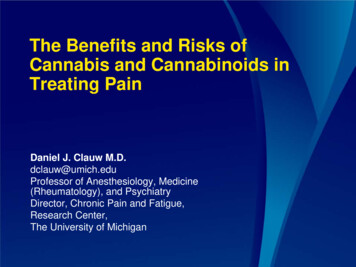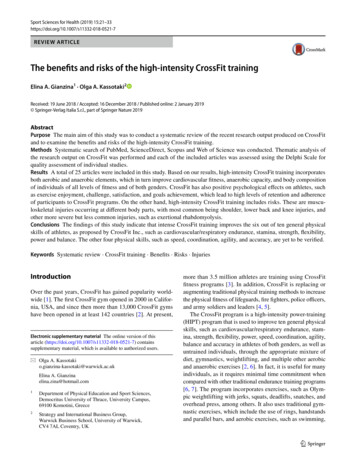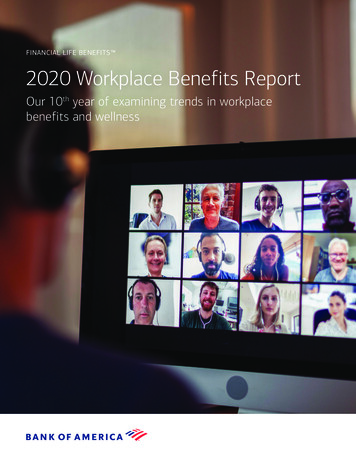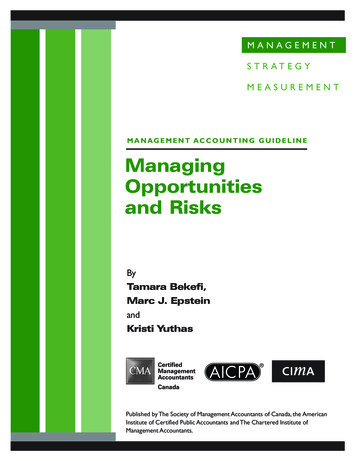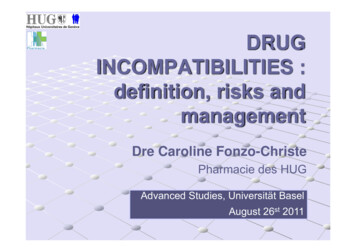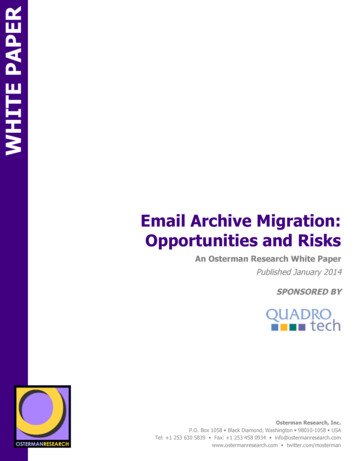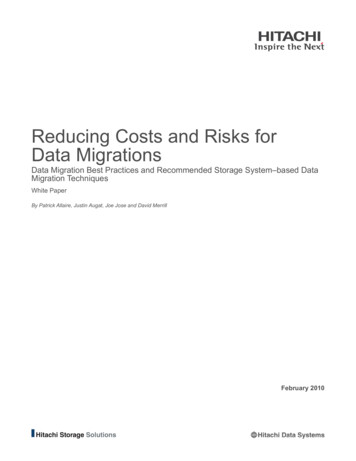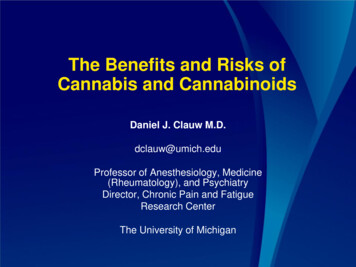
Transcription
The Benefits and Risks ofCannabis and CannabinoidsDaniel J. Clauw M.D.dclauw@umich.eduProfessor of Anesthesiology, Medicine(Rheumatology), and PsychiatryDirector, Chronic Pain and FatigueResearch CenterThe University of Michigan
Disclosures Consulting Pfizer, Forest, Eli Lilly, Pierre Fabre, Cypress Biosciences, Wyeth,UCB, AstraZeneca, Merck, J & J, Nuvo, Jazz, Abbott, Cerephex, Iroko,Tonix, Theravance, IMC, Zynerba, Sammumed, AptinyxResearch support Pfizer, Cypress Biosciences, Forest, Merck, Nuvo, Cerephex Testifying on behalf of State of Oklahoma against opioidmanufacturers Went to the University of Michigan in the 1970’s
Benefits and Risks of Cannabinoids Definitions and Background Benefits of Cannabinoids Risks of Cannabinoids Role in Treating Chronic Pain Summary
Benefits and Risks of Cannabinoids Definitions and Background Benefits of Cannabinoids Risks of Cannabinoids Role in Treating Chronic Pain Summary
Definitions Cannabis – A genus of flowering plants with three differentspecies: indica, sativa, and ruderalis Can be bred to have low amounts of psychoactive compounds (e.g.THC) that are used to make hemp, or high amounts that are used forrecreational/medicinal purposesSativex is a oral spray that is a cannabis extractCannabinoid – Compounds that act at cannabinoid receptors Endocannabinoids – endogenous ligands produced naturally that bindto CB1 and CB2 receptorsPhytocannabinoids – plant origin (cannabis/marijuana) At least 80 different cannabinoids in cannabisSynthetic cannabinoidsCB, cannabinoid receptor; THC, tetrahydrocannabinolPertwee RG. Handb Exp Pharmacol. 2005;(168):1-51.
Endocannabinoid system - IA set of receptors and their naturally occurring ligandsand enzymes regulating control Receptors – G-coupled protein receptors (the most abundant in CNS inman) on presynaptic membrane of cells in peripheral and central nervoussystemCB1 – Primarily in central nervous system (but not in medulla in man) these actprimarily to inhibit release of neurotransmitters CB2 – Largely found in periphery on immune and nerve cells (although some inCNS on microglia and DRG) Other receptors can bind these ligands because there is activity in CB1/CB2knockouts (TRPV1, GPR55) CB, cannabinoid receptor; CNS, central nervous system, DRG, dorsal root ganglionPertwee RG. Handb Exp Pharmacol. 2005;(168):1-51.
CB, cannabinoid receptorImage source: Crowe S, et al. Brain Behav ImmunCrowe S, et al. Brain Behav Immun. 2014;42:1-5.
Cannabis-derived cannabinoidsMore than 80 known, with different strains having differentrelative concentrations THC (Synthetic forms include Dronabinol, Marinol, Nabilone) The primary psychoactive cannabinoid in cannabis, and its metabolitesare those assayed for in drug testsAlthough it binds relatively equally to both the CB1 and CB2 receptors,most of its effects are associated with CB1 activity in brainCBD (cannabidiol) Seems to be generally very well toleratedIs not psychoactive and does not bind with any significant affinity to CBreceptors, but yet has anticonvulsant and anti-inflammatory effectsIs actually thought to potentially protect against psychoactive effects ofTHC and hypothesized by some to be an effective anti-psychotic(although a recent Cochrane review concluded there was insufficientevidence of this)CB, cannabinoid receptor; THC, TetrahydrocannabinolPertwee RG. Handb Exp Pharmacol. 2005;(168):1-51.
Benefits and Risks of Cannabinoids Definitions and Background Benefits of Cannabinoids Risks of Cannabinoids Role in Treating Chronic Pain Summary
Potential Benefits of Cannabinoids Antiemetic1 – Marinol is FDA-approved (Schedule III) for use in postchemotherapy nausea/vomiting Anorexia – Marinol is FDA-approved for this use in AIDS-inducedanorexia in US Anti-spasticity agent2 Anticonvulsant3 – Focus on CBD effects NeuroprotectiveBeing studied in Alzheimer’s4 because preclinical models show CB1/2activation leads to reduction in beta-amyloid Retrospective study of patients admitted with severe TBI showed significantreduction in death in those who had a positive drug screen for THC5 Anti-tumor effects6AIDS, acquired immune deficiency syndrome; CB, cannabinoid receptor; CBD, cannabidiol; FDA, Food and Drug Administration; TBI, traumatic braininjury; THC, tetrahydrocannabinol1. Sharkey K, et al. Eur J Pharm. 2014; 722:134-46. 2. Koppel, et al. Neurology. 2014;82:1556-63. 3. Devinsky O. Epilepsia;2014:55:791-802.4. Aso E, et. al. Front Pharmacol. 2014;5:37. 5. Nguyen BN. Am Surg. 2014;80:979-83. 6. Cridge B, Rosengren RJ. Cancer Manag Res. 2013;5:301-13.
Benefits and Risks of Cannabinoids Definitions and Background Benefits of Cannabinoids Risks of Cannabinoids Role in Treating Chronic Pain Summary
Risks of Cannabinoids Almost all available data is from long term recreational users so weprobably have good “worst case” data Partly related to route of administration Smoking cannabis may lead to chronic bronchitis and potentially cancer of themouth, throat, lung This is likely reduced or eliminated with use of vaporizers or e-cigarettes Oral administration causes less “likability” than inhalation or smoking andpresumably no risk of bronchitis or cancer Individuals using cannabis for medicinal purposes should probably be using anoral formulation but dosing is problematic The few deaths associated with cannabis are generally due to severeparanoia or tachycardia associated with overdose via oral administrationDegenhardt L, Hall WD. CMAJ. 2008;178:1685-6.
Long Term Risks of Cannabinoids1 Psychotic illnesses It is now generally accepted that individuals who begin smoking cannabis priorto age 25 have 1.5 – 2.4X the rate of developing a psychotic illness2 This risk is modified by childhood trauma, family history of a psychotic illness,and perhaps genetic polymorphisms Long term effects on memory and brain structure Both neuropsychological testing, and functional and structural neuroimagingstudies, have suggested that individuals who use cannabis recreationallybeginning in adolescence have decreased cognitive performance1,3 These studies have significant methodological issues because of othercommon exposures (e.g. alcohol or other illicit drugs) and behavioral issues inthese individuals31. Hall W. Drug Test Analysis 2014:6:39-45 2. Radhakrishnan R. Front Pharmacol. 2014:5:1-6. 3. James A, et al. Psychiatry Res. 2013;214:181-9.3. Batalla A. PLOSone 2013;8:e55821.
Risks of Cannabinoids1 Respiratory Dependence Occurs in approximately 9% of individuals who use cannabis, but isabout double in those who begin using in adolescenceThis is lower than almost all other drugs of abuse (nicotine 32%,opioids 23%, alcohol 15%)Highest risk in those with poor academic achievement, deviantbehavior in childhood, poor parental relationships, family history ofsubstance abusePhysical addiction and withdrawal are much less common/severe thanother drugs of abuse1. Hall W. Drug Test Analysis 2014:6:39-45 2. Radhakrishnan R. Front Pharmacol. 2014:5:1-6. 3. James A, et al. Psychiatry Res. 2013;214:181-9.
Comparison of classification systems for the harms and risks of drug abuse in the developmentof the multi-category Nutt rational scaleCorrelation between mean scores from the independent experts and the specialist addictionpsychiatrists 1 heroin. 2 cocaine. 3 alcohol. 4 barbiturates. 5 amphetamine. 6 methadone.7 benzodiazepines. 8 solvents. 9 buprenorphine. 10 tobacco. 11 ecstasy. 12 cannabis. 13 LSD.14 steroidsNutt D, et al. Lancet. 2007 Mar 24;369(9566):1047-53.
Is there a link between marijuanaand cancer? Smokedmarijuana delivers THC and othercannabinoids to the body, but it also deliversharmful substances to users and those close by,including many of the same substances found intobacco smoke, which are harmful to the lungs andcardiovascular system. Researchershave found limited evidence of anassociation between current, frequent, or chronicmarijuana smoking and testicular cancer (nonseminoma-typeNational Academies of Sciences E, and Medicine. (2017). The health effects of cannabis and21cannabinoids.
Cannabis and motor vehicle accidents Drivingwhile impaired by any substance, includingmarijuana, is dangerous. Marijuana, like alcohol,negatively affects a number of skills required forsafe driving: Marijuana can slow your reaction time and ability to makedecisions. Marijuana use can impair coordination, distort perception,and lead to memory loss and difficulty in problem-solving. Therisk of impaired driving associated withmarijuana in combination with alcohol appears to begreater than that for either by itself. Lateststatistics in states that have legalizedcannabis suggests very small increase in MVA (3%)but no increase in fatalities22
Benefits and Risks of Cannabinoids Definitions and Background Benefits of Cannabinoids Risks of Cannabinoids Role in Treating Chronic Pain Summary
Cannabis clinical trials for chronic pain Limited: short length and small sample size Many used THC alone or THC CBD Most support for use of cannabinoids in neuropathic pain(THC CBD). Increased risk of short term AEs (mostly minor) for studyparticipantsWhiting, Penny F., et al. Jama 313.24 (2015): 2456-2473.Nugent, Shannon M., et al. Annals of internal medicine 167.5 (2017): 319-331.25
Anti-inflammatory effects of CBD There are many animal models where CBD has beendemonstrated to have potent anti-inflammatory effects in avariety of models (including murine collagen arthritis andcarrageenan models) but it is much less clear how thoseanti-inflammatory effects are being mediated Some evidence that anti-inflammatory effects might beoccurring via CB2 (very high doses needed), adenosinereceptors, arachidonic acid release (causes shift fromcyclooxygenase to lipoxygenase pathway), via directinhibition of cytokine production, or via binding to theGPR55 receptor (which has both inflammatory andnociceptive properties)CB, cannabinoid receptor; CBD, cannabidiol; GPR55, G protein-coupled receptor 55Burstein S. Bioorg Med Chem. 2015;23:1377-85.
ZYN002 - Median Weekly Average Worst Knee PainScore over Time - Males27
PharmacokineticsAgurell, Stig, et al. Pharmacological Reviews 38.1 (1986): 21-43.32
Feelings of ‘high’ from differentadministration routesAgurell, Stig, et al. Pharmacological Reviews 38.1 (1986): 21-43.33
U-Shaped Curve for cannabis effectsEffectsDose1. Hill KP. Jama. 2015;313(24):2474. 2. Wallace M, Schulteis G, Atkinson JH, Wolfson T, Lazzaretto D, Bentley H, et al.Anesthesiology. 2007;107(5):785–96. 3. Portenoy RK, Ganae-Motan ED, Allende S, Yanagihara R, Shaiova L, Weinstein S, et al.J Pain. Elsevier Ltd; 2012;13(5):438–49.34
Cannabis as an opioid substitute forchronic pain? Cannabisas a synergist withopioids?1,2 State-wideanalyses3-5 Importanceof Dispensaries inthese studies (Powell et al, g11/images/acetamenophen%20and%20codeine.jpg Cross-sectional6-8andlongitudinal support9-111. Elikottil, Jaseena, et al. Journal of opioid management (2009). 2. Abrams et al, Clinical Pharmacology and Therapeutics, (2011). 3.Bachhuber MA et. al. JAMA Int Med (2014). 4. Bradford and Bradford Health Affairs, (2016) 5. Bradford and Bradford, Health Affairs(2017). 6. Boehnke, Kevin F., Evangelos Litinas, and Daniel J. Clauw. The Journal of Pain (2016). 7. Lucas et al, Journal ofInternational Drug Policy (2017) 8. Reiman et al, Cannabis and Cannabinoid Research (2017). 9. Haroutounian et al,. Clinical Journal36of Pain (2016). 10. Stith et al, PLOSone (2017) 11. Abuhasira et al, European Journal of Internal Medicine, (2018)
Proposed marketing program for medicalcannabisCannabis plant talking to opiumproducing poppy plantWe don’tsuck asbad as youdo
Benefits and Risks of Cannabinoids Definitions and Background Benefits of Cannabinoids Risks of Cannabinoids Role in Treating Chronic Pain Summary
Pragmatic Advice for UsingCannabinoids in 2019 Where possible use a cannabinoid or cannabinoid extract ofconsistent and known potency Start with CBD alone and then go to low dose of low THC:highCBD strain and go up slowly Emerging evidence of U-shaped curve Oral dosing better once stable dose and strain identified The strongest recommendation based on current benefit: riskdata is for the use of cannabinoids instead of opioids forneuropathic or centralized pain states Data from US suggest that legalizing cannabis in a state leads to fairly dramaticreductions in opioid overdoses1Use with caution in individuals under age 25CBD, cannabidiol; THC, tetrahydrocannabinol1. Bachhuber MA, et. al. JAMA Int Med 2014;174:1668-73.
Sep 04, 2019 · Comparison of classification systems for the harms and risks of drug abuse in the development of the multi-category Nutt rational scale Correlation between mean scores from the independent experts and the specialist addiction psychiatrists 1 heroin. 2 cocain
